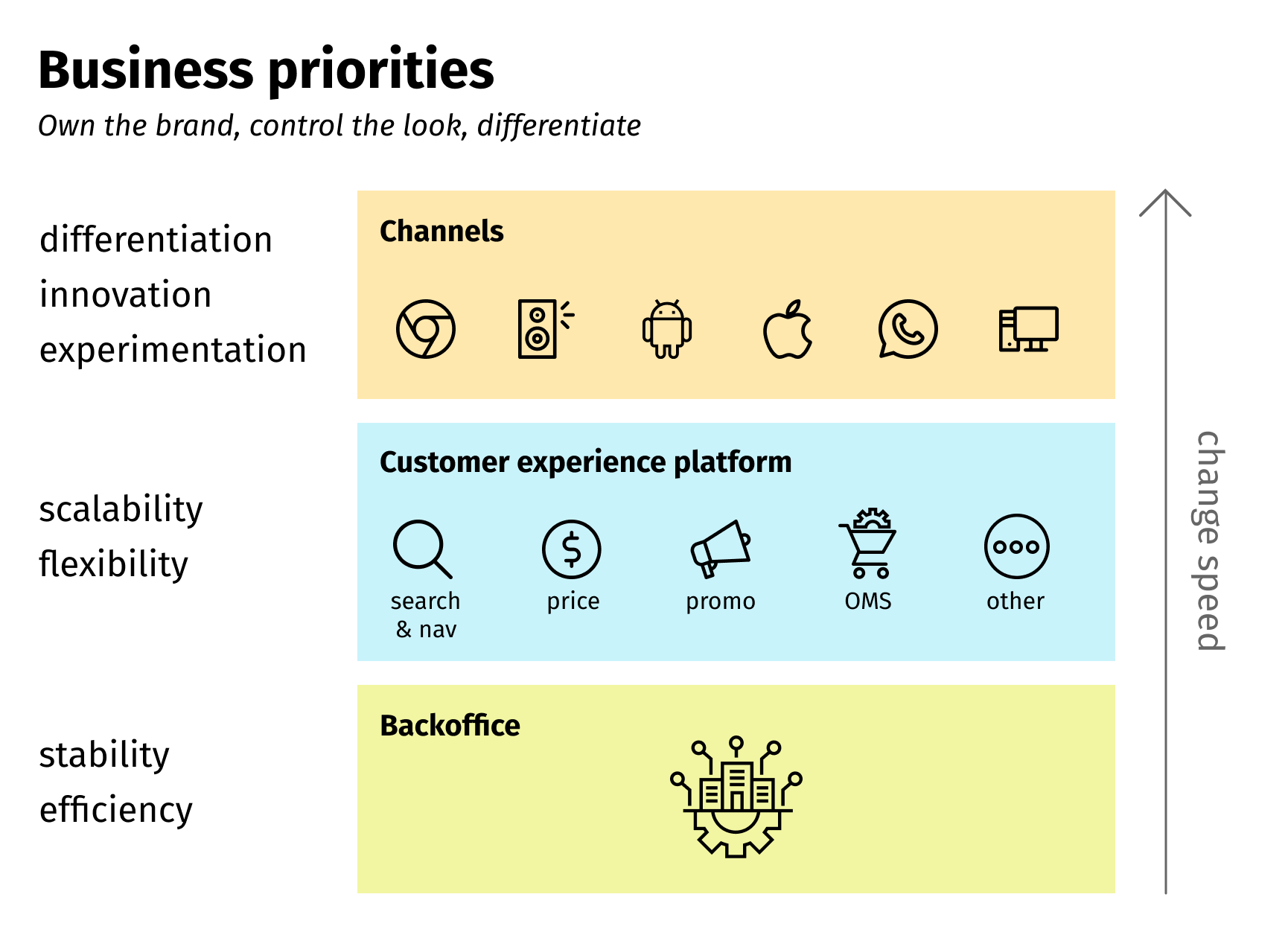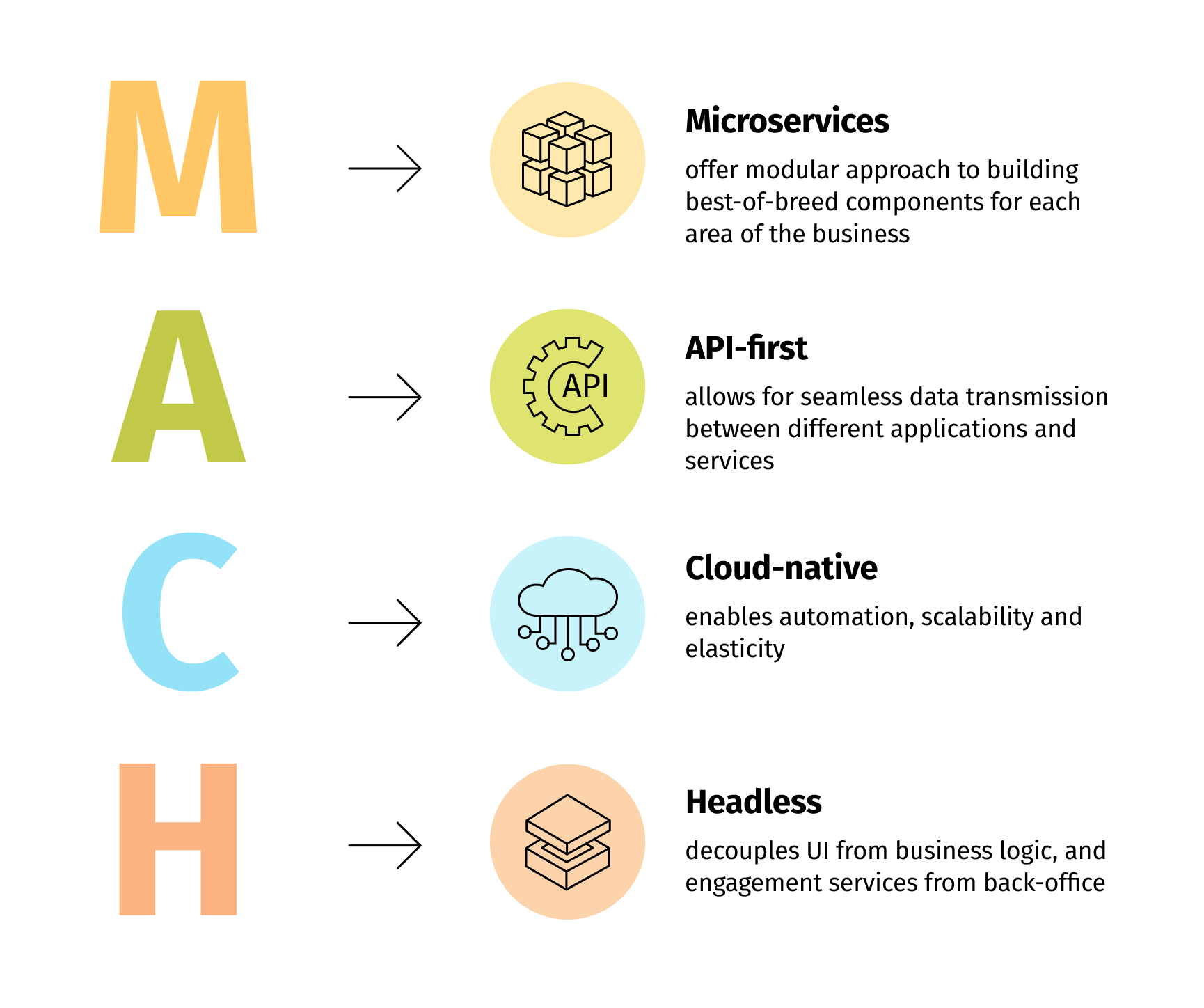
Achieving business flexibility with composable commerce
Ecommerce software has come a long way and achieved remarkable progress, turning from relatively simple applications into complex platforms rich in features and functionality. Back in the days when Amazon and eBay started their first online businesses, monolith architecture was virtually the only option to create digital commerce solutions.
Since then, cloud computing ignited a revolution in the way we develop software. Massively distributed, affordable and democratized infrastructure, containerization and cloud-native platforms enabled a rise of microservices, API-first, cloud and headless (MACH) architectures. Thus, the pendulum has swung from an all-in-one monolithic commerce platform to a highly modular approach with composable commerce as its apex.
Evolution of digital commerce platforms

Challenges of monolithic approach
Many of today’s leading retail enterprises built their first digital commerce platforms on a monolith architecture. Such application suites are quite easy to use as all the crucial components are tied together into a single system. The all-inclusive monolith solution would typically encompass all the essential functionality like product catalog, search engine, shopping cart, payment, and shipping, while additional capabilities can be delivered through customization or extensions.
Having everything in one place can be a seemingly convenient solution. However, as the business expands the challenges of working within a monolithic framework grow too. While monolithic apps feature a small number of moving parts and components that are fully integrated with one another, they prove to be quite rigid in terms of responsiveness to business needs.
For one thing, it’s because in monolith architecture the user interface is so intricately bound with the server-side logic that the smallest modification of any user-facing component will inevitably lead to disruptions throughout the entire platform. In addition, there is a difference in the rate of change in the system layers. Top layers are fixing to introduce changes that would allow innovation and experimentation, while bottom layers prioritize stability and efficiency.
This presents immense complexity for the software engineering team, leading to slow development speed, dependencies, and zero possibility of gradual scaling. That same complexity means that retailers can not respond quickly enough to consumer behavior changes or emerging market trends to keep the edge over the competition.

Embracing change with MACH architecture
The transition from an all-in-one handyman to modern intelligent commerce architecture didn’t happen overnight. This advancement has been driven by gradual modularization and fragmentation of ecommerce solutions, emergence of API-powered digital ecosystems, the rise of the cloud, and continuous improvement of the customer interface. Together these prime movers are known as MACH architecture – Microservices, API-first, Cloud-native, and Headless.
Microservices
A microservices architecture offers a decentralized approach, where instead of a single solution that encompasses as many business capabilities as possible, there are multiple autonomous interconnected services. Each microservice is purpose-built to fulfill a single goal, and it typically takes several pieces to create a complex business function. For instance, if you want to build a shopping cart you will need to assemble product inventory, recommendations, pricing, discounts, ordering, and checkout microservices to do the trick.
At first glance, managing numerous solutions instead of a single-tier structure may seem like a daunting task. However, it provides flexibility and agility the monolith fails to offer. Microservices can be developed, updated, and upgraded independently from each other, without impacting any other pieces of the system. This translates to easy scalability, high uptime, and faster deployment and rollout of new features.
With microservices, you can also enjoy state-of-the-art technology without licensing restrictions from a single provider. The modular approach allows you to mix and match best-of-breed components for each area of your business. As your choice is not limited by out-of-box features only – you can easily add, swap or remove various capabilities as your needs grow and change. You are also able to create and integrate your own internal microservices that are fine-tuned to your specific business problems.
API-first
API-first approach makes an API a first-class citizen in the system as all the communication between its components happens only through the API. Thus, shared databases, UI-based automation, file exchanges and other communication backdoors are strictly prohibited. This enforces the isolation of the modules and enables simple substitution of the component implementation, as soon as the API remains unchanged.
API democratizes access to data and services, greatly improving productivity of teams. Additionally, API-first allows integration of dependent components as soon as API is stabilized, even before full functionality is delivered.
Cloud-native
Cloud-native refers to the concept of building and running applications which are designed to fully leverage the concepts and power of cloud computing. It focuses on loosely coupled systems encompassing containers, service mesh, microservices, immutable infrastructure-as-a-code, horizontal elastic scalability and managed cloud services.
This approach enables speed-to-market and just-in-time scalability which is especially important for retailers during peak times – from Halloween to Black Friday, all the way to Christmas celebrations and New Year's Eve. Within the last three months of the year, retailers dispatch 25% of annual total orders. Without the elastic scalability of the cloud, retailers would have to deploy holiday capacity months in advance to sustain the peak, keeping the system under-utilized throughout the year.
Headless
Headless commerce refers to the complete decoupling of the customer-facing presentation layer (‘head’) from backend business logic (‘body’), with the two sides being connected through APIs. The practical implication is that most headless platforms store content and data in a way that’s not tied to any particular front-end. They have no pre-configured graphical interfaces but can still make use of pre-built UI components and templates to accelerate the introduction of the final product.
The decoupled nature of headless platforms allows companies to deploy multiple frontend interfaces at a wide range of touchpoints. This helps retailers to connect with buyers wherever they are, providing a curated customer experience based on the channel or end-user device.
As the frontend and backend are operating separately, the development team can make updates to the user interface without affecting essential eCommerce components. They can experiment with various front-end options like IoT or voice commerce, ensuring the platform can meet both current and future customer needs.

PBCs: the next round in the development of digital commerce
Packaged business capabilities (PBCs) comprise an aggregation of functionalities that serve a specific business function. They can deliver additional value by quickly supporting updates, improvement and innovation.
PBCs are typically implemented as a cohesive group of microservices and can vary from micro to macro capabilities. The crucial requirement about PBC is API-first approach to enable seamless integration into the ecosystem.
Packaged Business Capabilities (PBCs) can be categorized into verticals, such as:
- Core commerce (shopping cart, check-out)
- Content management system
- Search engine (semantic vector search, visual search, smart autosuggest)
- Reviews and ratings
- Customer identity management
- Customer loyalty
- Customer service (help desk, chatbot).
Each of these modules can be built either in-house or with API-first SaaS products provided by third-party vendors. This enables enterprises to experiment and leverage newer technologies to create a custom digital commerce application that will fit the brand's unique requirements.
Composable commerce: the future is now
The idea of composable commerce brings online shopping to a whole new level. It embarks on the shift from an inward-looking platform-centric view to an outward-looking approach focused on customer experience.
The urge to take a leap forward from conventional ways of doing business and move toward future-proof digital commerce experiences was most strongly felt during the Covid-19 pandemic. According to McKinsey, the crisis has spurred a change in shopping habits, with an astonishing 75% of consumers trying a new shopping method or incorporating different product brands, retailers, stores, and websites into their routine.
The proliferation of digital channels and the way customers expect to engage with brands at each touchpoint compelled retailers to prioritize flexibility, agility and speed. As stated in US consumer sentiment and behaviors during the coronavirus crisis report, 60-70% of consumers are researching and purchasing goods both in-store and online across mobile, web, and social media. This trend shows that omnichannel is on the rise and retailers should be ready to embrace the changes in consumer behavior.
Composable commerce opportunities
Expect the unexpected
With modular architecture, retailers can construct, deconstruct and reconstruct their digital platform again and again to meet the evolving needs of their audience. Each component of the system – from core commerce technology and a customer relationship management (CRM) system, to help desk and content – can be deployed and evolved independently, offering flexibility to swap modules out over time.
Use best-in-class solutions
The composable approach utilizes various PBCs from different vendors and weaves them together, creating an open technology ecosystem that encourages seamless integration and customization. Built on open standards, the platform is thus capable of gluing best-in-class boxed services with your custom code to solve more complex business challenges.
Spice up user interface design
Thanks to the headless nature of modern digital commerce solutions you can not only assemble a unique stack of features but also differentiate with UI/UX to reach out to new customer types, channels, and markets. By adhering to principles of composable commerce you gain more control over the look and feel of your application and its overall performance.
Enable speed-to-market
In the traditional monolith world, any upgrades of the system would entail code changes, regression testing, and only after that, deployment to production. The whole process could therefore take several weeks depending on how many updates were made.
The composable model, on the other hand, offers continuous integration and delivery, quality automation, and agility. According to Gartner, within the next year, companies that opted for a composable approach will outpace their competitors by 80% in the speed of new feature implementation.
Future-proof your business
Composable commerce is likely to become the new norm across enterprise applications in the next couple of years, as it’s the only option to achieve the flexibility needed to support a fast-moving digital business. If you want to keep up with the pace of change in customer demand it is advisable to start the transition from a monolithic eCommerce platform to modern architecture right away. Create a roadmap and proceed step-by-step with implementing individual capabilities, while gradually strangling the legacy components.
Final thoughts
Composable commerce is about giving brands and retailers the flexibility to achieve their business goals and satisfy ever-changing customer needs. It offers enterprises the freedom to select best-of-breed solutions for every aspect of their business operations, allowing them to make rapid changes to their technology stack, create a personalized user experience for each client, and become more competitive in the global market.

